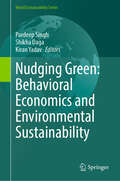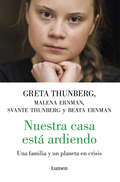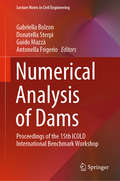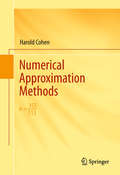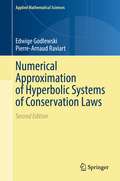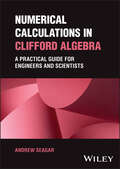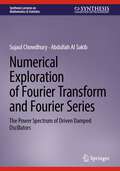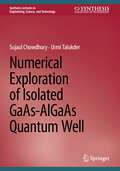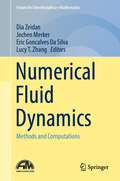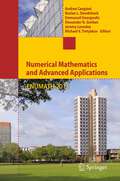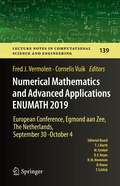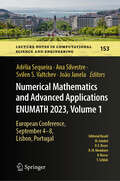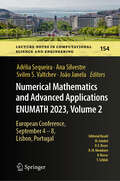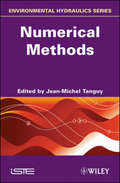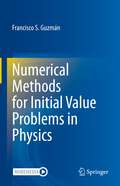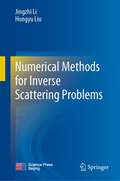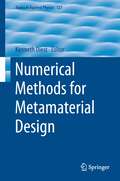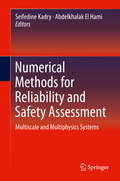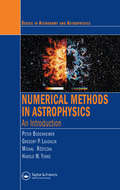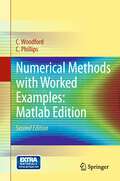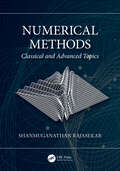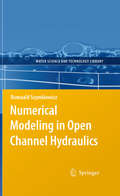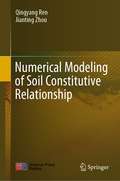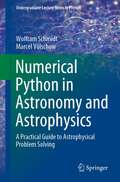- Table View
- List View
Nudging Green: Behavioral Economics and Environmental Sustainability (World Sustainability Series)
by Pardeep Singh Shikha Daga Kiran YadavOur use or rather overuse of natural resources is having an increasingly drastic and adverse effect on the environment. Behavioural economics uses the concepts and elements of psychology and applies them in economic decision-making. It has been identified that behavioural economics can be used to tackle the issue of climate change by using ‘nudges’ to influence people to make choices that are more eco-friendly. Behavioural economics also accept the presence of cognitive biases in the decision-making process, and one solution to reduce the biases is instigating ‘nudges’ that increase the probability of making optimal decisions. The book therefore provides an in-depth understanding of the environmental and climatic issues and the role played by people’s psychology in addressing them. The book highlights cognitive biases and nudges that can be used to negate or reduce the negative impact of decision-making on the environment. The book provides a detailed explanation of the topic along with illustrations, tables, and case studies that make it easy to understand and apply the concepts. The methods, results, and topics covered in the book will be of particular interest to readers interested in behavioural economics, sustainable development, environmental conservation, and various biases that impact decision-making and the nudges that are used and can be used to bring environment protection. The main benefit that readers will derive from the book is a comprehensive understanding of behaviour, biases and nudge-based solutions and their potential to address major challenges faced while making decisions. The book is helpful for policymakers, researchers, practitioners, and students interested in behavioural economics, biases, sustainable development, and environmental protection.
Nuestra casa está ardiendo: Una familia y de un planeta en crisis
by Varios Autores Greta ThunbergEsta es la historia de una familia que afronta su propia crisis enfrentándose a una crisis aún mayor: la de nuestro planeta #HuelgaPorElClima «Quiero que actúen como si nuestra casa estuviera ardiendo. Porque así es.» Con estas palabras cerraba Greta Thunberg su discurso en el foro de Davos el 25 de enero de 2019, cinco meses después de iniciar su huelga por el clima. Desde entonces, la activista ha sumado a millones de personas a su lucha para salvar el planeta. Pero ¿qué llevó a una adolescente de quince años a tomar la decisión de plantarse en solitario ante el Parlamento de su país y desde allí intentar cambiar el mundo? Esta historia, escrita por la familia Thunberg y narrada por la voz de la madre, la cantante de ópera Malena Ernman, comienza cuando la pequeña Greta cae en una depresión severa y deja de comer por el impacto de un documental sobre el cambio climático. Sus padres emprenden una batalla feroz por su salud hasta que le diagnostican síndrome de Asperger, autismo de alto funcionamiento y TOC. Al poco tiempo, la hija menor, Beata, muestra signos de trastornos similares. Este es el grito de auxilio de una niña para convencer, primero a los suyos y luego al mundo, de que la sociedad está tan enferma como el planeta y de que es urgente que reaccione. Una narración sobrecogedora de una familia moderna que supera su propia crisis desafiando una crisis global. La crítica ha dicho...«Esta época necesita gente como Greta. Las ideas están en el aire y hace falta alguien que las formule.»Svetlana Alexiévich «Escuchemos a Greta. Tal vez todavía estemos a tiempo.»J. M. G. Le Clézio «El relato extraordinario de cómo una familia logra erguirse, con gran lucidez moral, ante la tremenda responsabilidad de estar vivos en el momento en que nuestras decisiones colectivas inmediatas están determinando el futuro de la vida en la Tierra. [...] Greta Thunberg ya ha inspirado un hito global: este libro guarda la esencia de cómo ganaremos.»Naomi Klein «La historia de Greta es sorprendente y emocionante. [...] No creo que exista un precedente similar en toda la historia: que una adolescente [...] lidere un movimiento de millones de personas.»David Wallace-Wells (autor de El planeta inhóspito), El País «Greta arde de autenticidad, es un puro aullido de desesperación y de incredulidad ante nuestra ceguera.»Rosa Montero «La familia Thunberg-Ernman narra de manera amena y con una sinceridad apabullante su paso devastador por los infiernos.»Eva Stegen, The Friday «Una lectura poderosa y convincente, distópica y optimista, personal y objetiva.»Marie Pettersson, Sydsvenskan «Un grito [...], un testimonio escrito ahora que el presagio de un desastre avanza. La propia crisis de una familia es, en realidad, una prueba de su inteligencia.»Sverker Sörlin, Dagens Nyheter «Un libro conmovedor.»Arno Widmann, Berliner Zeitung «Una mirada sorprendente e introspectiva de una familia que vive adaptándose a los reveses del destino.»Steffen Trumpf, dpa «Valiente y tenaz.»Anna Hellgren, Expressen «Una historia extraordinaria y emocionante.»Alexandra von Poschinger, Passauer Neue Presse
Numerical Analysis of Dams: Proceedings of the 15th ICOLD International Benchmark Workshop (Lecture Notes in Civil Engineering #91)
by Gabriella Bolzon Donatella Sterpi Guido Mazzà Antonella FrigerioThis book gathers contributions from the 15th ICOLD Benchmark Workshop on Numerical Analysis of Dams. The workshop provided an opportunity for engineers, researchers and operators to present and exchange their experiences and the latest advances in numerical modelling in the context of the design, performance and monitoring of dams. Covering various aspects of computer analysis tools and safety assessment criteria, and their development over recent decades, the book is a valuable reference resource for those in the engineering community involved in the safety, planning, design, construction, operation and maintenance of dams.
Numerical Approximation Methods: π ≈ 355/113
by Harold CohenThis book presents numerical and other approximation techniques for solving various types of mathematical problems that cannot be solved analytically. In addition to well known methods, it contains some non-standard approximation techniques that are now formally collected as well as original methods developed by the author that do not appear in the literature. This book contains an extensive treatment of approximate solutions to various types of integral equations, a topic that is not often discussed in detail. There are detailed analyses of ordinary and partial differential equations and descriptions of methods for estimating the values of integrals that are presented in a level of detail that will suggest techniques that will be useful for developing methods for approximating solutions to problems outside of this text. The book is intended for researchers who must approximate solutions to problems that cannot be solved analytically. It is also appropriate for students taking courses in numerical approximation techniques.
Numerical Approximation of Hyperbolic Systems of Conservation Laws (Applied Mathematical Sciences #118)
by Edwige Godlewski Pierre-Arnaud RaviartThis monograph is devoted to the theory and approximation by finite volume methods of nonlinear hyperbolic systems of conservation laws in one or two space variables. It follows directly a previous publication on hyperbolic systems of conservation laws by the same authors. Since the earlier work concentrated on the mathematical theory of multidimensional scalar conservation laws, this book will focus on systems and the theoretical aspects which are needed in the applications, such as the solution of the Riemann problem and further insights into more sophisticated problems, with special attention to the system of gas dynamics. This new edition includes more examples such as MHD and shallow water, with an insight on multiphase flows. Additionally, the text includes source terms and well-balanced/asymptotic preserving schemes, introducing relaxation schemes and addressing problems related to resonance and discontinuous fluxes while adding details on the low Mach number situation.
Numerical Calculations in Clifford Algebra: A Practical Guide for Engineers and Scientists
by Andrew SeagarNUMERICAL CALCULATIONS IN CLIFFORD ALGEBRA An intuitive combination of the theory of Clifford algebra with numerous worked and computed examples and calculations Numerical Calculations in Clifford Algebra: A Practical Guide for Engineers and Scientists is an accessible and practical introduction to Clifford algebra, with comprehensive coverage of the theory and calculations. The book offers many worked and computed examples at a variety of levels of complexity and over a range of different applications making extensive use of diagrams to maintain clarity. The author introduces and documents the Clifford Numerical Suite, developed to overcome the limitations of existing computational packages and to enable the rapid creation and deployment of sophisticated and efficient code. Applications of the suite include Fourier transforms for arrays of any types of Clifford numbers and the solution of linear systems in which the coefficients are Clifford numbers of particular types, including scalars, bicomplex numbers, quaternions, Pauli matrices, and extended electromagnetic fields. Readers will find: A thorough introduction to Clifford algebra, with a combination of theory and practical implementation in a range of engineering problems Comprehensive explorations of a variety of worked and computed examples at various levels of complexity Practical discussions of the conceptual and computational tools for solving common engineering problems Detailed documentation on the deployment and application of the Clifford Numerical Suite Perfect for engineers, researchers, and academics with an interest in Clifford algebra, Numerical Calculations in Clifford Algebra: A Practical Guide for Engineers and Scientists will particularly benefit professionals in the areas of antenna design, digital image processing, theoretical physics, and geometry.
Numerical Exploration of Fourier Transform and Fourier Series: The Power Spectrum of Driven Damped Oscillators (Synthesis Lectures on Mathematics & Statistics)
by Sujaul Chowdhury Abdullah Al SakibThis book presents practical demonstrations of numerically calculating or obtaining Fourier Transform. In particular, the authors demonstrate how to obtain frequencies that are present in numerical data and utilizes Mathematica to illustrate the calculations. This book also contains numerical solution of differential equation of driven damped oscillator using 4th order Runge-Kutta method. Numerical solutions are compared with analytical solutions, and the behaviors of mechanical system are also depicted by plotting velocity versus displacement rather than displaying displacement as a function of time. This book is useful to physical science and engineering professionals who often need to obtain frequencies present in numerical data using the discrete Fourier transform.This book: Aids readers to numerically calculate or obtain frequencies that are present in numerical dataExplores the use of the discrete Fourier transform and demonstrates practical numerical calculationUtilizes 4th order Runge-Kutta method and Mathematica for the numerical solution of differential equation
Numerical Exploration of Isolated GaAs-AlGaAs Quantum Well (Synthesis Lectures on Engineering, Science, and Technology)
by Sujaul Chowdhury Urmi TalukderThis book begins with the eigenvalue equation of energy and presents calculation of the energy spectrum of GaAs-AlGaAs Quantum Well using finite difference method and knowledge of potential energy profile, without using expressions for eigenfunctions, continuity of eigenfunctions, or their spatial derivatives at the two abrupt potential steps. The authors find that the results are almost the same as those obtained by solving numerically using regula falsi method, and transcendental equations that are obeyed by the energy levels, where the transcendental equations are obtained by requiring continuity of eigenfunctions and of their spatial derivatives at the two potential steps. Thus, this book confirms that it is possible to numerically calculate the energy spectrum of Quantum Well by the finite difference method when it is not correct or when it is not possible to use continuity of eigenfunctions and their spatial derivatives at the two abrupt potential steps. The authors also showthat it is possible to use the finite difference method in cases where the potential steps are non-abrupt. The book demonstrates this by calculating the energy spectrum of isolated parabolic Quantum Well of finite depth using finite difference method.
Numerical Fluid Dynamics: Methods and Computations (Forum for Interdisciplinary Mathematics)
by Dia Zeidan Lucy T. Zhang Eric Goncalves Da Silva Jochen MerkerThis book contains select invited chapters on the latest research in numerical fluid dynamics and applications. The book aims at discussing the state-of-the-art developments and improvements in numerical fluid dynamics. All the chapters are presented for approximating and simulating how these methods and computations interact with different topics such as shock waves, non-equilibrium single and two-phase flows, elastic human-airway, and global climate. In addition to the fundamental research involving novel types of mathematical sciences, the book presents theoretical and numerical developments in fluid dynamics. The contributions by well-established global experts in fluid dynamics have brought different features of numerical fluid dynamics in a single book. The book serves as a useful resource for high-impact advances involving computational fluid dynamics, including recent developments in mathematical modelling, numerical methods such as finite volume, finite difference and finite element, symbolic computations, and open numerical programs such as OpenFOAM software. The book addresses interdisciplinary topics in industrial mathematics that lie at the forefront of research into new types of mathematical sciences, including theory and applications. This book will be beneficial to industrial and academic researchers, as well as graduate students, working in the fields of natural and engineering sciences. The book will provide the reader highly successful materials and necessary research in the field of fluid dynamics.
Numerical Mathematics and Advanced Applications 2011
by Alexander N. Gorban Andrea Cangiani Emmanuil Georgoulis Jeremy Levesley Michael V. Tretyakov Ruslan L DavidchackThe European Conferences on Numerical Mathematics and Advanced Applications (ENUMATH) are a series of conferences held every two years to provide a forum for discussion of new trends in numerical mathematics and challenging scientific and industrial applications at the highest level of international expertise. ENUMATH 2011 was hosted by the University of Leicester (UK) from the 5th to 9th September 2011. This proceedings volume contains more than 90 papers by speakers of the conference and gives an overview of recent developments in scientific computing, numerical analysis, and practical use of modern numerical techniques and algorithms in various applications. New results on finite element methods, multiscale methods, numerical linear algebra, and finite difference schemes are presented. A range of applications include computational problems from fluid dynamics, materials, image processing, and molecular dynamics.
Numerical Mathematics and Advanced Applications ENUMATH 2019: European Conference, Egmond aan Zee, The Netherlands, September 30 - October 4 (Lecture Notes in Computational Science and Engineering #139)
by Cornelis Vuik Fred J. VermolenThis book gathers outstanding papers presented at the European Conference on Numerical Mathematics and Advanced Applications (ENUMATH 2019). The conference was organized by Delft University of Technology and was held in Egmond aan Zee, the Netherlands, from September 30 to October 4, 2019. Leading experts in the field presented the latest results and ideas regarding the design, implementation and analysis of numerical algorithms, as well as their applications to relevant societal problems.ENUMATH is a series of conferences held every two years to provide a forum for discussing basic aspects and new trends in numerical mathematics and scientific and industrial applications, all examined at the highest level of international expertise. The first ENUMATH was held in Paris in 1995, with successive installments at various sites across Europe, including Heidelberg (1997), Jyvaskyla (1999), lschia Porto (2001), Prague (2003), Santiago de Compostela (2005), Graz (2007), Uppsala (2009), Leicester (2011), Lausanne (2013), Ankara (2015) and Bergen (2017).
Numerical Mathematics and Advanced Applications ENUMATH 2023, Volume 1: European Conference, September 4-8, Lisbon, Portugal (Lecture Notes in Computational Science and Engineering #153)
by Adélia Sequeira Ana Silvestre Svilen S. Valtchev João JanelaThis book gathers outstanding papers presented at the European Conference on Numerical Mathematics and Advanced Applications, ENUMATH 2023. The conference was held in Lisbon, Portugal, in September 2023. Leading experts in the field presented the latest results and ideas regarding the design, implementation and analysis of numerical algorithms, as well as their applications to relevant societal problems. ENUMATH is a series of conferences held every two years to provide a forum for discussing basic aspects and new trends in numerical mathematics and its scientific and industrial applications, all examined at the highest level of international expertise. The first ENUMATH was held in Paris in 1995, with successive installments at various sites across Europe, including Heidelberg (1997), Jyvaskyla (1999), lschia Porto (2001), Prague (2003), Santiago de Compostela (2005), Graz (2007), Uppsala (2009), Leicester (2011), Lausanne (2013), Ankara (2015), Bergen (2017), and Egmond aan Zee (2019).
Numerical Mathematics and Advanced Applications ENUMATH 2023, Volume 2: European Conference, September 4-8, Lisbon, Portugal (Lecture Notes in Computational Science and Engineering #154)
by Adélia Sequeira Ana Silvestre Svilen S. Valtchev João JanelaThis book gathers outstanding papers presented at the European Conference on Numerical Mathematics and Advanced Applications, ENUMATH 2023. The conference was held in Lisbon, Portugal, in September 2023. Leading experts in the field presented the latest results and ideas regarding the design, implementation and analysis of numerical algorithms, as well as their applications to relevant societal problems. ENUMATH is a series of conferences held every two years to provide a forum for discussing basic aspects and new trends in numerical mathematics and its scientific and industrial applications, all examined at the highest level of international expertise. The first ENUMATH was held in Paris in 1995, with successive installments at various sites across Europe, including Heidelberg (1997), Jyvaskyla (1999), lschia Porto (2001), Prague (2003), Santiago de Compostela (2005), Graz (2007), Uppsala (2009), Leicester (2011), Lausanne (2013), Ankara (2015), Bergen (2017), and Egmond aan Zee (2019).
Numerical Methods
by Jean-Michel TanguyThis series of five volumes proposes an integrated description of physical processes modeling used by scientific disciplines from meteorology to coastal morphodynamics. Volume 1 describes the physical processes and identifies the main measurement devices used to measure the main parameters that are indispensable to implement all these simulation tools. Volume 2 presents the different theories in an integrated approach: mathematical models as well as conceptual models, used by all disciplines to represent these processes. Volume 3 identifies the main numerical methods used in all these scientific fields to translate mathematical models into numerical tools. Volume 4 is composed of a series of case studies, dedicated to practical applications of these tools in engineering problems. To complete this presentation, volume 5 identifies and describes the modeling software in each discipline.
Numerical Methods for Initial Value Problems in Physics
by Francisco S. GuzmánThis textbook is a comprehensive overview of the construction, implementation, and application of important numerical methods for the solution of Initial Value Problems (IVPs). Beginning with IVPs involving Ordinary Differential Equations (ODEs) and progressing to problems with Partial Differential Equations (PDEs) in 1+1 and 3+1 dimensions, it provides readers with a clear and systematic progression from simple to complex concepts. The numerical methods selected in this textbook can solve a considerable variety of problems and the applications presented cover a wide range of topics, including population dynamics, chaos, celestial mechanics, geophysics, astrophysics, and more. Each chapter contains a variety of solved problems and exercises, with code included. These examples are designed to motivate and inspire readers to delve deeper into the state-of-the-art problems in their own fields. The code is written in Fortran 90, in a library-free style, making them easy to program and efficient to run. The appendix also includes the same code in C++, making the book accessible to a variety of programming backgrounds. At the end of each chapter, there are brief descriptions of how the methods could be improved, along with one or two projects that can be developed with the methods and codes described. These projects are highly engaging, from synchronization of chaos and message encryption to gravitational waves emitted by a binary system and non-linear absorption of a scalar field. With its clear explanations, hands-on approach, and practical examples, this textbook is an essential resource for advanced undergraduate and graduate students who want to the learn how to use numerical methods to tackle challenging problems.
Numerical Methods for Inverse Scattering Problems
by Jingzhi Li Hongyu LiuThis book highlights the latest developments on the numerical methods for inverse scattering problems associated with acoustic, electromagnetic, and elastic waves. Inverse scattering problems are concerned with identifying unknown or inaccessible objects by wave probing data, which makes possible many industrial and engineering applications including radar and sonar, medical imaging, nondestructive testing, remote sensing, and geophysical exploration. The mathematical study of inverse scattering problems is an active field of research. This book presents a comprehensive and unified mathematical treatment of various inverse scattering problems mainly from a numerical reconstruction perspective. It highlights the collaborative research outputs by the two groups of the authors yet surveys and reviews many existing results by global researchers in the literature. The book consists of three parts respectively corresponding to the studies on acoustic, electromagnetic, and elastic scattering problems. In each part, the authors start with in-depth theoretical and computational treatments of the forward scattering problems and then discuss various numerical reconstruction schemes for the associated inverse scattering problems in different scenarios of practical interest. In addition, the authors provide an overview of the existing results in the literature by other researchers. This book can serve as a handy reference for researchers or practitioners who are working on or implementing inverse scattering methods. It can also serve as a graduate textbook for research students who are interested in working on numerical algorithms for inverse scattering problems.
Numerical Methods for Metamaterial Design
by Kenneth DiestThis book describes a relatively new approach for the design of electromagnetic metamaterials. Numerical optimization routines are combined with electromagnetic simulations to tailor the broadband optical properties of a metamaterial to have predetermined responses at predetermined wavelengths. After a review of both the major efforts within the field of metamaterials and the field of mathematical optimization, chapters covering both gradient-based and derivative-free design methods are considered. Selected topics including surrogate-base optimization, adaptive mesh search, and genetic algorithms are shown to be effective, gradient-free optimization strategies. Additionally, new techniques for representing dielectric distributions in two dimensions, including level sets, are demonstrated as effective methods for gradient-based optimization. Each chapter begins with a rigorous review of the optimization strategy used, and is followed by numerous examples that combine the strategy with either electromagnetic simulations or analytical solutions of the scattering problem. Throughout the text, we address the strengths and limitations of each method, as well as which numerical methods are best suited for different types of metamaterial designs. This book is intended to provide a detailed enough treatment of the mathematical methods used, along with sufficient examples and additional references, that senior level undergraduates or graduate students who are new to the fields of plasmonics, metamaterials, or optimization methods; have an understanding of which approaches are best-suited for their work and how to implement the methods themselves.
Numerical Methods for Reliability and Safety Assessment
by Abdelkhalak El Hami Seifedine KadryThis book offers unique insight on structural safety and reliability by combining computational methods that address multiphysics problems, involving multiple equations describing different physical phenomena and multiscale problems, involving discrete sub-problems that together describe important aspects of a system at multiple scales. The book examines a range of engineering domains and problems using dynamic analysis, nonlinear methods, error estimation, finite element analysis and other computational techniques. This book also: · Introduces novel numerical methods · Illustrates new practical applications · Examines recent engineering applications · Presents up-to-date theoretical results · Offers perspective relevant to a wide audience, including teaching faculty/graduate students, researchers and practicing engineers.
Numerical Methods in Astrophysics: An Introduction (Series in Astronomy and Astrophysics)
by Peter Bodenheimer Tomasz Plewa Gregory P. Laughlin Michal Rozyczka Harold. W YorkeNumerical Methods in Astrophysics: An Introduction outlines various fundamental numerical methods that can solve gravitational dynamics, hydrodynamics, and radiation transport equations. This resource indicates which methods are most suitable for particular problems, demonstrates what the accuracy requirements are in numerical simulations, a
Numerical Methods of Exploration Seismology: With Algorithms in MATLAB®
by Gary F. Margrave Michael P. LamoureuxExploration seismology uses seismic imaging to form detailed images of the Earth's interior, enabling the location of likely petroleum targets. Due to the size of seismic datasets, sophisticated numerical algorithms are required. This book provides a technical guide to the essential algorithms and computational aspects of data processing, covering the theory and methods of seismic imaging. The first part introduces an extensive online library of MATLAB® seismic data processing codes maintained by the CREWES project at the University of Calgary. Later chapters then focus on digital signal theory and relevant aspects of wave propagation and seismic modelling, followed by deconvolution and seismic migration methods. Presenting a rigorous explanation of how to construct seismic images, it provides readers with practical tools and codes to pursue research projects and analyses. It is ideal for advanced students and researchers in applied geophysics, and for practicing exploration geoscientists in the oil and gas industry.
Numerical Methods with Worked Examples: Matlab Edition
by C. Phillips C. WoodfordThis book is for students following an introductory course in numerical methods, numerical techniques or numerical analysis. It introduces MATLAB as a computing environment for experimenting with numerical methods. It approaches the subject from a pragmatic viewpoint; theory is kept at a minimum commensurate with comprehensive coverage of the subject and it contains abundant worked examples which provide easy understanding through a clear and concise theoretical treatment. This edition places even greater emphasis on 'learning by doing' than the previous edition. Fully documented MATLAB code for the numerical methods described in the book will be available as supplementary material to the book on http://extras.springer.com
Numerical Methods: Classical and Advanced Topics
by Shanmuganathan RajasekarThis book presents a pedagogical treatment of a wide range of numerical methods to suit the needs of undergraduate and postgraduate students, and teachers and researchers in physics, mathematics, and engineering. For each method, the derivation of the formula/algorithm, error analysis, case studies, applications in science and engineering and the special features are covered. A detailed presentation of solving time-dependent Schrödinger equation and nonlinear wave equations, along with the Monte Carlo techniques (to mention a few) will aid in students’ understanding of several physical phenomena including tunnelling, elastic collision of nonlinear waves, electronic distribution in atoms, and diffusion of neutrons through simulation study.The book covers advanced topics such as symplectic integrators and random number generators for desired distributions and Monte Carlo techniques, which are usually overlooked in other numerical methods textbooks. Interesting updates on classical topics include: curve fitting to a sigmoid and Gaussian functions and product of certain two functions, solving of differential equations in the presence of noise, and solving the time-independent Schrödinger equation.Solutions are presented in the forms of tables and graphs to provide visual aid and encourage a deeper comprehension of the topic. The step-by-step computations presented for most of the problems can be verifiable using a scientific calculator and is therefore appropriate for classroom teaching. The readers of the book will benefit from acquiring an acquittance, knowledge, experience and realization of significance of the numerical methods covered, their applicability to physical and engineering problems and the advantages of applying numerical methods over theoretical methods for specific problems.
Numerical Modeling in Open Channel Hydraulics
by Romuald SzymkiewiczThis book offers a comprehensive approach to the numerical modeling of open channel flow, based on the author's own research in this field, as well as his experience as a lecturer. It provides the reader with: Coverage of the most important problems of open channel hydraulics, including steady and unsteady flow in a single channel and in a channel network, transport of dissolved substance, transport of energy and more;Unified derivation of the governing equations for all problems, based on the fundamental laws of mass, momentum and energy conservation;Comprehensive presentation of the numerical methods applied in open channel flow modeling, with particular regard to the solution of hyperbolic and parabolic partial differential equations, which govern many important flow and transport processes;Detailed description of the numerical algorithms applied to solve particular problems, with many examples of solutions; Accuracy analysis of the numerical algorithms using the modified equation approach; New insights into numerical solution of some classical problems of open channel hydraulics, e.g. steady varied flow in a channel of arbitrary geometry.In-depth analysis of the simplified flood routing models and their unphysical properties, including a proposition of an alternative Instantaneous Unit Hydrograph, valid for all simplified models.Written in an accessible language, Numerical Modeling in Open Channel Hydraulics contains information useful for higher level undergraduate and postgraduate students of civil and environmental engineering faculties, as well as scientists and practitioners in the field of hydraulic engineering, especially those using existing numerical codes or developing their own ones.
Numerical Modeling of Soil Constitutive Relationship
by Qingyang Ren Jianting ZhouThis book adopts numerical method to model soil constitutive relationship while it abandons the traditional idea of looking for plastic potential as the only way to model. Firstly, the triaxial compression tests of expansive soil, sand and clay under different stress paths are introduced; then the elastoplastic constitutive equations of expansive soil, sand and clay under various stress paths are established by numerical modeling method; finally, the constitutive equations are embedded in the finite element program and verified by comparing the finite element calculation results of the triaxial test soil samples with the corresponding test results. The modeling obtains high accuracy.
Numerical Python in Astronomy and Astrophysics: A Practical Guide to Astrophysical Problem Solving (Undergraduate Lecture Notes in Physics)
by Wolfram Schmidt Marcel VölschowThis book provides a solid foundation in the Python programming language, numerical methods, and data analysis, all embedded within the context of astronomy and astrophysics. It not only enables students to learn programming with the aid of examples from these fields but also provides ample motivation for engagement in independent research. The book opens by outlining the importance of computational methods and programming algorithms in contemporary astronomical and astrophysical research, showing why programming in Python is a good choice for beginners. The performance of basic calculations with Python is then explained with reference to, for example, Kepler’s laws of planetary motion and gravitational and tidal forces. Here, essential background knowledge is provided as necessary. Subsequent chapters are designed to teach the reader to define and use important functions in Python and to utilize numerical methods to solve differential equations and landmark dynamical problems in astrophysics. Finally, the analysis of astronomical data is discussed, with various hands-on examples as well as guidance on astronomical image analysis and applications of artificial neural networks.
